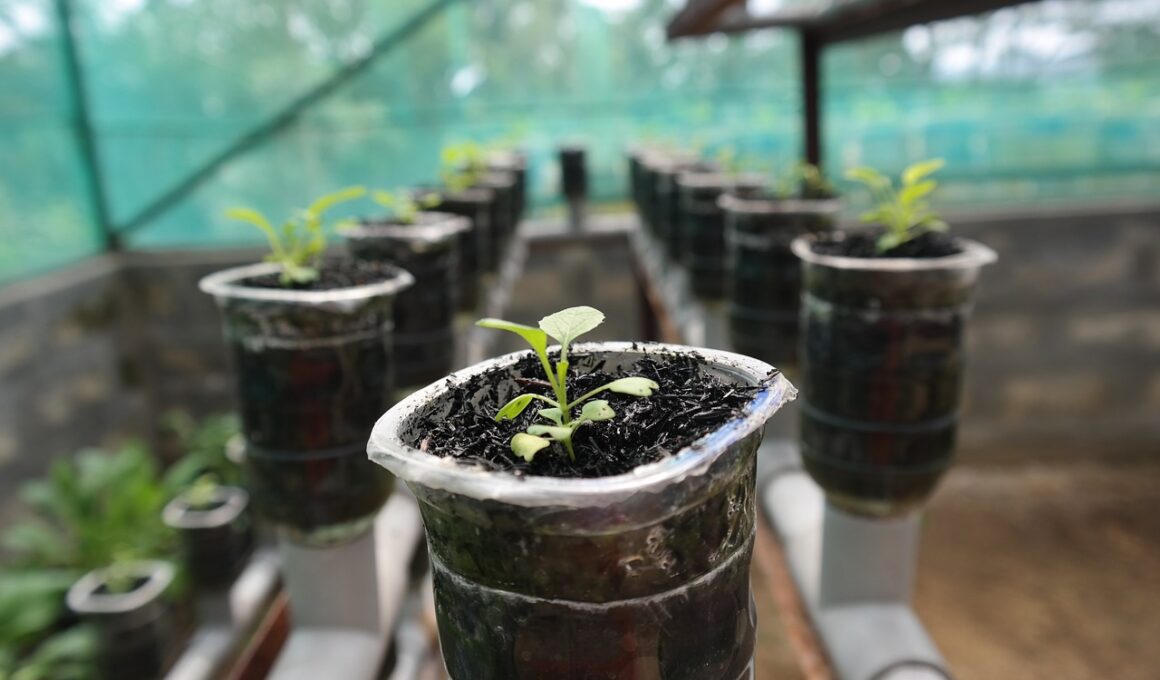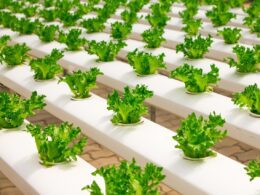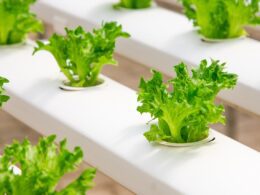Do you ever wonder if you’re watering your plants correctly? Are you giving them enough nutrients to thrive? Knowing how long nutrients should sit in water before watering your plants can make a big difference in their health and growth.
Understanding the science behind nutrient absorption in plants can help you maximize the benefits of your watering routine. When you water your plants, you’re not just providing them with water, but also essential nutrients that they need to sustain their growth and development. However, the timing of nutrient absorption is critical, and if you’re not timing it correctly, your plants may not be getting the nutrients they need.
In this article, we’ll explore the factors that influence nutrient absorption in plants, and how to ensure that your plants are getting the most out of their watering routine.
Understanding Nutrient Absorption in Plants
You’ll absorb more nutrients from your plants if you understand how they take in nourishment. Factors affecting nutrient absorption include the type of plant, soil type, and pH level. It’s important to ensure that the nutrients you provide to your plants are in a form that they can take up easily.
Nutrient mobility in soil also plays a role in how long nutrients should sit in water before watering plants. Some nutrients, like nitrogen, are highly mobile and can move through the soil quickly. Others, like phosphorus, are less mobile and can remain in the soil for longer periods of time. This means that you may need to adjust your watering schedule based on the specific nutrients your plants require.
In order to ensure that your plants are getting the nutrients they need, it’s important to monitor their growth and adjust your fertilization schedule accordingly. By understanding how nutrients are absorbed by your plants and how they move through the soil, you can provide optimal conditions for growth and ensure a healthy harvest.
The Timing of Nutrient Absorption
The timing of nutrient absorption plays a crucial role in the growth and health of plants. Optimal absorption of nutrients is essential for plants to thrive.
In general, plants absorb nutrients in two stages: the initial uptake and the steady uptake.
During the initial uptake stage, plants absorb nutrients that are immediately available in the soil. This process occurs within the first few hours after watering.
After the initial uptake, plants enter the steady uptake stage, where they absorb nutrients that are released slowly from the soil. These nutrients become available over a period of time and can be absorbed by the plant for several days.
To ensure optimal absorption and nutrient availability for your plants, it’s essential to time your watering correctly. Experts suggest that you water your plants when the soil is dry to the touch, but not completely dried out. This allows for the initial uptake stage to occur, and for the plant to absorb nutrients that are immediately available in the soil.
Overwatering can lead to nutrient deficiency as excess water can wash away essential nutrients, making them less available to the plant.
Incorporating the right timing for nutrient absorption is crucial for the health and growth of your plants. By allowing for the initial uptake stage to occur, you can ensure that your plants have access to the nutrients they need to thrive. Remember to water your plants when the soil is dry to the touch, and avoid overwatering to ensure that your plants have access to the nutrients they need.
Tips for Maximizing Nutrient Absorption
Maximizing nutrient absorption is crucial for healthy and thriving plants, and there are simple yet effective tips to achieve this. One important tip is to pre-soak your seeds before planting them. This allows the seeds to absorb water and nutrients, which can jumpstart their growth. By pre-soaking your seeds, you can ensure that your plants will have a strong foundation and be more resistant to disease and pests.
Another way to maximize nutrient absorption is through foliar feeding. This involves spraying a nutrient-rich solution onto the leaves and stems of your plants. The nutrients are absorbed through the leaves and can be quickly transported to different parts of the plant. Foliar feeding is especially useful during times of stress, such as drought or extreme temperatures, when the roots may not be able to absorb enough nutrients.
Lastly, it’s important to use the right amount of nutrients and to avoid overfeeding your plants. Too much fertilizer can actually harm your plants and lead to nutrient burn. It’s important to follow the instructions on the fertilizer package and to monitor your plants for any signs of nutrient deficiency or excess.
By following these simple tips, you can help your plants to absorb the nutrients they need to thrive and grow strong. So, don’t forget to pre-soak your seeds, try foliar feeding, and use the right amount of nutrients for optimal plant health.
Common Mistakes to Avoid
If you want your plants to thrive, it’s crucial to avoid common mistakes that can hinder their growth and health. One of the most common mistakes is overwatering. Plants need water to grow, but too much of it can lead to root rot and other problems.
Before watering your plants, make sure the top inch of soil is dry. This will ensure that you’re not overwatering and that your plants are getting the right amount of moisture.
Another mistake to avoid is not considering the nutrient concentration levels in your water. Nutrients are essential for plant growth, but too much or too little can be harmful. When adding nutrients to your water, make sure to follow the instructions on the label carefully.
Over-fertilizing can lead to nutrient burn, which can cause leaves to turn yellow or brown and eventually die. Under-fertilizing can lead to stunted growth and poor yields.
To ensure that your plants are getting the right amount of nutrients, it’s important to monitor the nutrient concentration levels in your water. This can be done using a TDS meter, which measures the total dissolved solids in the water. Aim for a nutrient concentration level of around 800-1000 ppm for most plants.
By avoiding these common mistakes, you can ensure that your plants are healthy and thriving.
Monitoring Plant Growth and Health
When monitoring your plants’ growth and health, it’s important to keep an eye out for signs of nutrient deficiencies. Adjusting your watering routine can also make a big difference in promoting healthy growth. If you’re unsure about how to address any issues that arise, don’t hesitate to seek professional help.
Adjust the paragraph structure in the Input to logically group complete sentences on their own lines, with a double new line after. Use contractions.
Signs of Nutrient Deficiencies
You’ll know when your plants are lacking important nutrients because they’ll show signs of deficiency that can be frustrating to witness. For instance, if your plant has yellowing leaves, it may be deficient in nitrogen.
If the leaves have brown spots, it might be lacking in potassium. And if the leaves are small and discolored, it might be suffering from an iron deficiency.
These signs can be alarming, but they’re also an opportunity to address the problem and provide your plants with the nutrients they need.
Identifying the causes of nutrient deficiencies is key to preventing them from occurring in the first place. Make sure your plants are getting enough sunlight, water, and nutrients. Avoid over-watering or under-watering, and use a high-quality fertilizer that’s appropriate for your plants.
By being proactive and taking steps to prevent nutrient deficiencies, you can keep your plants healthy and thriving.
Adjusting Your Watering Routine
Now that you know the signs of nutrient deficiencies, it’s time to adjust your watering routine to ensure your plants are getting the proper nutrients they need.
One important factor to consider is the frequency of your watering. It’s important to not overwater or underwater your plants as both can lead to nutrient deficiencies.
To determine the proper watering frequency, you need to consider the soil moisture levels. Here are three things to keep in mind when adjusting your watering routine:
-
Check the soil moisture level before watering. Stick your finger about an inch into the soil and if it feels dry, it’s time to water.
-
Make sure you are watering thoroughly. Water until it starts to drain out the bottom of the pot to ensure the entire root system is getting nutrients.
-
Adjust your watering frequency based on the season. In the summer, plants may need to be watered more frequently due to increased temperatures and evaporation. In the winter, plants may need less water due to decreased temperatures and lower light levels.
By following these tips, you can ensure that your plants are getting the proper nutrients they need to thrive. Remember, proper watering routine is key to preventing nutrient deficiencies and keeping your plants healthy.
Seeking Professional Help if Needed
If you’re struggling to keep your plants healthy despite adjusting your watering routine, consider seeking professional help. There are a variety of assistance options available to you, from online forums to local gardening clubs. However, if you’re still having trouble, it may be time to consider expert consultation.
Don’t be afraid to reach out to a professional gardener or plant specialist. They can help you identify any underlying issues with your plants, such as nutrient deficiencies or pests. They can also provide personalized advice on how to care for your specific plants and help you create a watering routine that works best for them. By seeking professional help, you can ensure your plants are getting the nutrients they need to thrive and grow.
| Assistance Options | Pros | Cons |
|---|---|---|
| Online forums | Free | Advice may not be reliable |
| Local gardening clubs | In-person support | Limited availability |
| Professional consultation | Personalized advice | Can be expensive |
As you can see from the table above, there are both pros and cons to each assistance option. While online forums are free, the advice may not always be reliable. Local gardening clubs can provide in-person support, but their availability may be limited. Professional consultation may be the most expensive option, but it also provides personalized advice that is tailored to your specific needs. Ultimately, the choice is yours, but don’t be afraid to seek out expert help if you need it. Your plants will thank you for it.
Frequently Asked Questions
What are the different methods of watering plants and how do they affect nutrient absorption?
Looking to optimize your plant’s nutrient absorption? Consider hydroponic systems or drip irrigation. These methods of watering plants provide a more direct and efficient delivery of nutrients to the roots.
Hydroponic systems involve growing plants in a nutrient-rich water solution rather than soil. Drip irrigation, on the other hand, utilizes a network of tubes to deliver water and nutrients directly to the plant’s roots.
By using these methods, you can ensure that your plants are getting the nutrients they need without any unnecessary waiting time. So why not give them a try and see the difference for yourself? Your plants will thank you for it!
Can over-watering plants affect nutrient absorption?
Over-watering your plants can have a negative impact on their nutrient retention. When soil moisture levels are too high, it can cause the nutrients to leach out of the soil before the plant has a chance to absorb them. This can ultimately lead to nutrient deficiencies and a weaker, less healthy plant.
To avoid this, it’s important to monitor the moisture levels in your soil and only water when necessary. Don’t let your plants sit in water for extended periods of time, as this can also lead to root rot and other issues. Instead, aim for a consistent watering schedule that allows for proper drainage and nutrient uptake.
By doing so, you can help ensure that your plants are getting the nutrients they need to thrive.
How do different types of soil affect nutrient absorption in plants?
When it comes to the nutrient absorption of plants, soil composition plays a crucial role. Different types of soil have varying levels of nutrient availability, which can impact the growth and health of your plants.
Sandy soils, for example, have low nutrient holding capacity and may require more frequent fertilization to maintain optimal nutrient levels. On the other hand, clay soils can hold onto nutrients for longer periods but may also be prone to waterlogging, which can lead to nutrient leaching.
Understanding your soil type and nutrient availability is key to ensuring your plants are getting the nutrients they need to thrive.
Are there any specific nutrients that are more important for certain types of plants?
When it comes to plant growth, certain nutrients play a bigger role for specific plant species. Identifying the nutrient deficiencies in different plant species is crucial for maintaining optimal growth.
For example, nitrogen is essential for plant growth and is often the limiting factor in crop production. Calcium is important for plants that grow in acidic soils, while iron is necessary for plants that grow in alkaline soils.
It’s important to note that each plant species has its own unique nutrient requirements, and providing them with the right nutrients can prevent nutrient deficiencies and promote healthy growth.
How do environmental factors such as temperature and humidity affect nutrient absorption in plants?
To ensure your plants are getting the nutrients they need, it’s important to take into account environmental factors such as temperature and humidity.
These factors can greatly influence nutrient availability and plant growth rate. For example, if the temperature is too high, the nutrients may become unavailable to the plants, leading to stunted growth.
On the other hand, if the humidity is too low, the plants may not be able to absorb the nutrients properly. It’s important to monitor these environmental factors and adjust accordingly to ensure your plants are thriving.
So, pay attention to your plants and their environment to ensure they’re getting the nutrients they need for optimal growth.
Conclusion
In conclusion, understanding how long nutrients should sit in water before watering your plants is crucial for their growth and overall health. Different types of plants have varying nutrient absorption rates, so it’s important to do your research beforehand. Timing is also key, as giving your plants too much or too little nutrients can have negative effects.
To maximize nutrient absorption, make sure to follow the manufacturer’s instructions and avoid common mistakes like over-watering or under-watering. Keep a close eye on your plants’ growth and health, and make adjustments as needed.
With these tips in mind, you can ensure that your plants are getting the right nutrients at the right time, leading to a beautiful and thriving garden.









